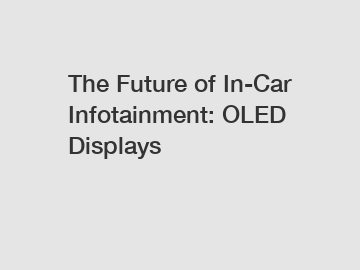The Future of In-Car Infotainment: OLED Displays
The Future of In-Car Infotainment: OLED Displays.
In recent years, the automobile industry has witnessed significant advancements in in-car infotainment systems. One such technology that has gained traction is the use of OLED displays. OLED, which stands for Organic Light-Emitting Diode, offers several advantages over traditional LCD displays, paving the way for an exciting future of in-car entertainment and information delivery.
Enhanced Visual Experience with OLED Displays.

One of the most prominent features of OLED displays is their ability to deliver exceptional image quality and vibrant colors. Unlike LCDs, which require backlighting, OLED displays emit their own light when an electric current is applied. This allows for deeper blacks, higher contrast ratios, and more accurate color reproduction. With such enhanced visual capabilities, OLED displays provide a stunning and immersive experience for passengers, making long journeys more enjoyable.
Seamless Integration and Customization.
OLED displays also offer flexibility in terms of design and integration within the vehicle's interior. Due to their organic nature, OLED panels can be made to be lightweight, thin, and flexible. This enables manufacturers to integrate displays seamlessly into the dashboard, doors, and even the steering wheel, providing a futuristic appearance. Moreover, OLED displays can be custom-made to fit various sizes and shapes, allowing car manufacturers to create unique and visually appealing designs tailored to their specific models.
Improved Energy Efficiency.
The energy efficiency of OLED displays is another aspect that makes them ideal for in-car infotainment systems. OLEDs are known for their self-emissive properties, meaning that each individual pixel is responsible for emitting light. This allows for greater energy savings, as only the active pixels consume power, while inactive pixels remain off. As a result, OLED displays consume less energy compared to LCDs, leading to longer battery life and reduced strain on the vehicle's electrical system.
Enhanced Safety and Usability.
In-car infotainment systems play a crucial role in providing occupants with information and entertainment while minimizing distractions. OLED displays contribute to this mission by offering improved safety and usability features. For instance, OLED displays can be made curved, matching the natural curvature of the dashboard or interior surfaces. This reduces glare and reflections, resulting in better visibility even when exposed to bright sunlight. Additionally, OLED displays have faster response times, enabling seamless transitions and minimizing input lag, thus enhancing user experience.
The Road Ahead with OLED Displays.
As OLED technology continues to advance, the future of in-car infotainment looks promising. Manufacturers are constantly exploring innovative ways to integrate OLED displays and capitalize on their many advantages. With the ongoing development of flexible OLED screens, we can expect to see even more futuristic and customizable interior designs in the automotive industry. Furthermore, advancements in manufacturing processes and cost reduction are likely to make OLED displays more accessible to a wider range of vehicles.
Conclusion.
OLED displays are revolutionizing the in-car infotainment experience, offering enhanced visual quality, seamless integration, improved energy efficiency, and enhanced safety. These displays provide a glimpse into the future of in-car entertainment, with their ability to offer stunning visuals, flexibility in design, and longer battery life. As the automobile industry continues to embrace OLED technology, it is critical for manufacturers, suppliers, and consumers to stay updated with the latest advancements and possibilities.
To know more about the future of in-car infotainment and the use of OLED displays, please contact us.
Keywords: contact us.
For more information, please visit htn lcd supplier, 2.7 oled, 2.7 oled display.
163
0
0

Comments
All Comments (0)